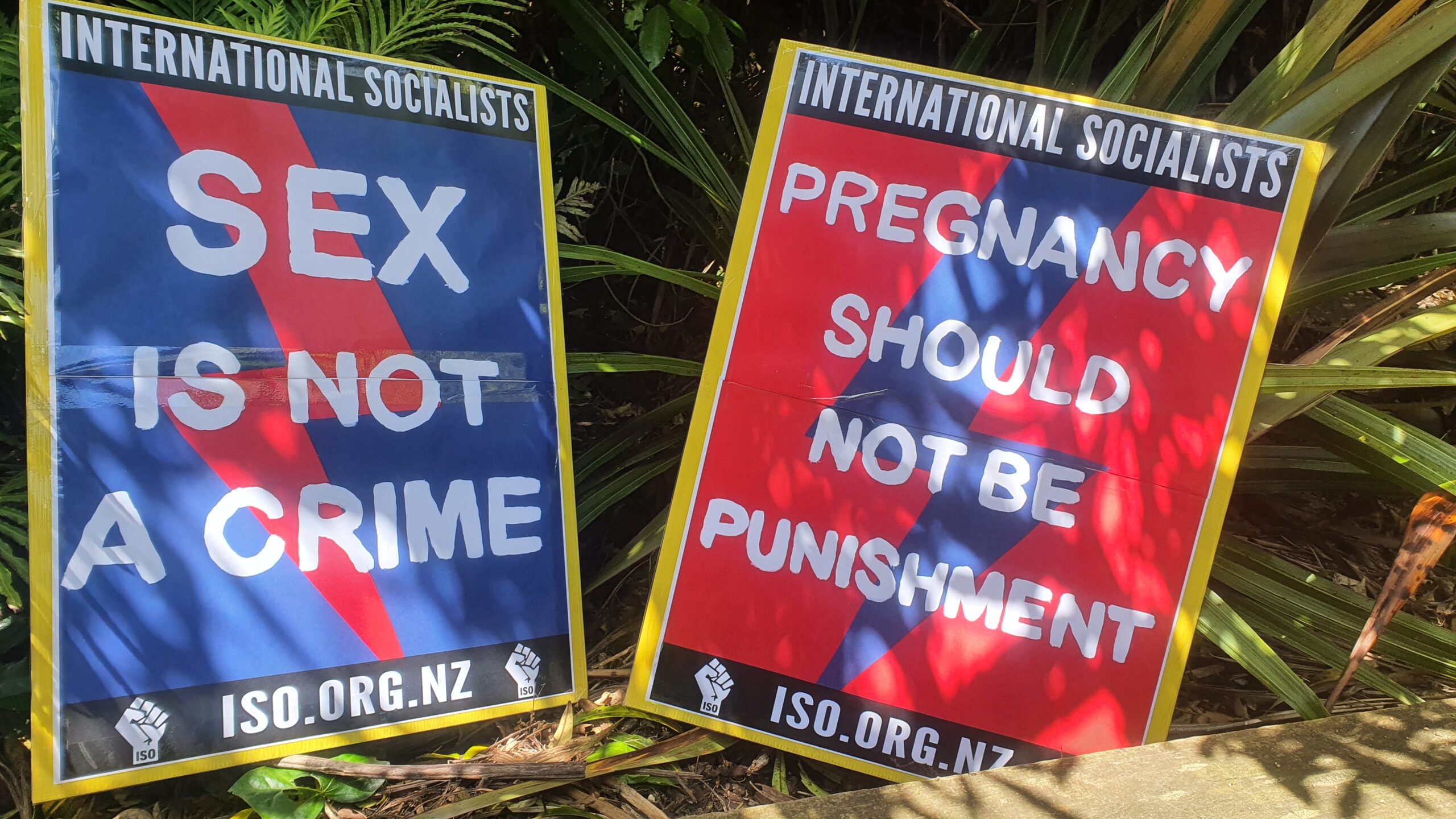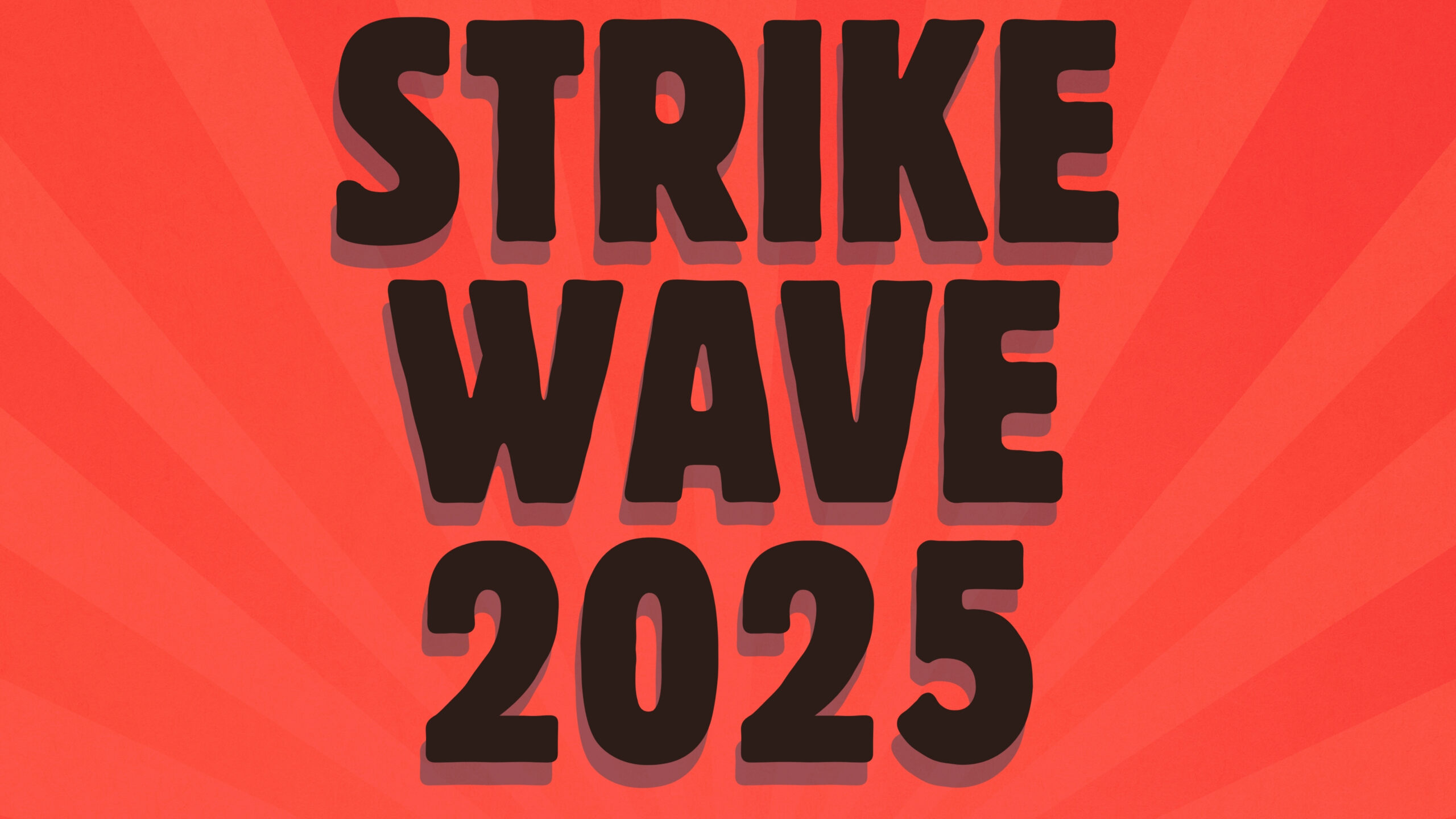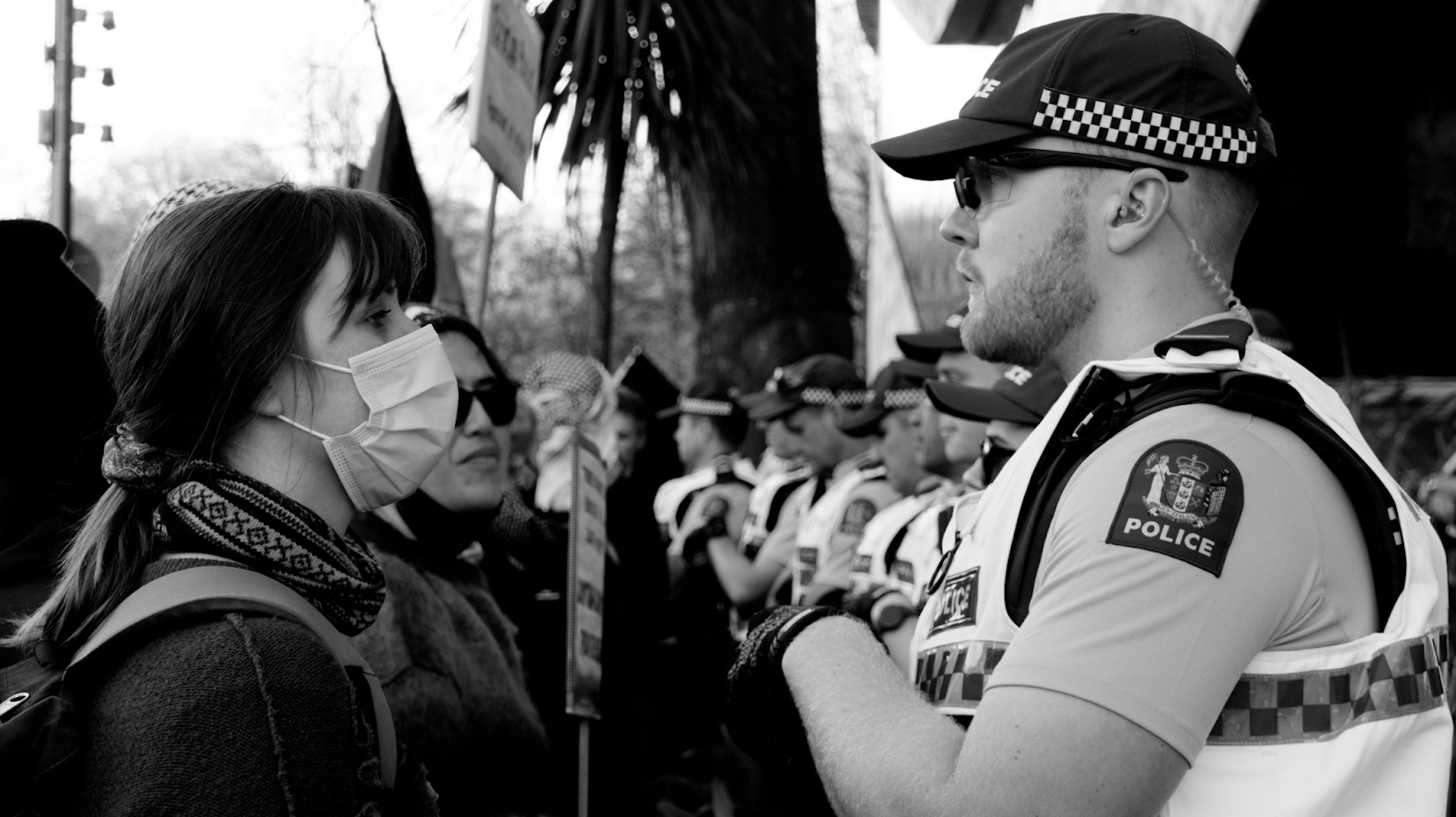On July 2nd, at 10am on a crisp but clear Saturday morning, left-wing activists under the banner of Antifascist Ōtepoti begun setting up for a counter-protest of the “It Ain’t Over March” by the Freedom and Rights Coalition (henceforth FRC), a right-wing activist group largely dedicated to continuing the efforts of this year’s occupation on parliament grounds. The mood was light and positive, despite some quiet anxiety. Police had warned that the FRC were expecting about 200 activists to march into the Octagon. Their activists were slinking around Antifascist Ōtepoti’s setup area and taking photos, while activists trickled in and the police presence began to surround the area.
The activists present were a combination of known elements of the labour and anti-capitalist movements, as well as what appeared to be a large presence of liberal-progressive types, mobilised by the local queer-friendly bar and cafe Woof! which had taken a fairly central role in contact work. Woof! had presented the counter-protest as a “counter-hate” rally, aimed at opposing the bigotry of Destiny Church and their affiliates.
A central organiser and spokesperson for Antifascist Ōtepoti, Sina Brown-Davis, said that “members of Ōtepoti’s diverse communities are uniting against fascism and the politics of hate… together we will stand up against fascism and to celebrate the power and strength of diversity and tolerance.”
Appointed safety wardens in high-vis vests gathered for their briefing, discussing the task of keeping activists safe and de-escalating conflict if necessary. Waiata rang out through the loudspeakers, and at 11am a karakia and introduction was given, as well as instructions and safety advice by organisers (march to the Octagon, take the upper Octagon, don’t talk to cops unless someone is in immediate danger). Dudley Benson of Woof! Took the stage to hype up the crowd, and spoke with great charisma against the leadership of FRC, particularly Derek Tait, who he likened to a phallic sex toy that he produced from his jacket. Nothing gets a crowd laughing like a bouncing dong toy.
Dance and Chants versus Scattergun Rhetoric
Shortly after, the crowd moved into the main street and marched towards the Octagon. The headcount ranged somewhere between 150 and 200 people. Chants of “Tangata whenua, Muslim, Asian and White, Unite! Unite! Unite to Fight the Right!” rang out as the crowd arrived, and took over the upper Octagon as planned. The Octagon had been chalked with anti-mandate and bigoted anti-transgender slogans, which were quickly erased and replaced. Local anti-transgender activists Jennifer Scott and Christina Harwood stood by the statue of Robbie Burns, shouting transphobic soundbites. They attempted and failed to snatch counter-protest signage, to which activists responded by stealing theirs, followed by Christina’s shouts of “police! They’ve stolen our property!” Soon the anti-fascist protestors switched to ignoring them, and activists took the bandstand, singing “Derek Tait, Derek Tait, Derek Tait and his Nazi Mates!” to the tune of Postman Pat. Meanwhile, police lined up along the street, and set up a full barricade with their vehicles, presumably to divert the FRC march towards the lower Octagon when they arrived.
The FRC arrived shortly after, a mere 40 or so activists, a far cry from the anticipated 200. Derek Tait had a good long chat with the police presence before their crowd advanced, moving into the lower Octagon.
The FRC had an impressively strong sound system and a generator, which they used to blast the national anthem and raps about the various crimes of Jacinda Ardern. This was countered by the anti-fascist camp, with a quiter sound system but many more voices, singing Lily Allen, ABBA, Village People, and other queer anthems.
Tait spoke for a good half an hour or so. He opened with a series of statements, suddenly and unpromptedly defending himself, explaining that he could not be a misogynist: he had daughters. He could not be an Islamophobe: he had Muslim mates. He could not be a bigot: his cousin is a lesbian. He apparently felt that some folks wanted to oppress him for his Christianity. Some airtime was given to how much he supports the police (very much counter to FRC statements on their website which label them agents of tyranny and corruption).
Tait spent most of his speaking time jeering at counter-protestors, and making broad statements about “freedom”. His planned comments on mandates and other supposed political arguments that they were rallying for were largely missing in action, asides to his stream-of-consciousness rather than a focus. To experienced activists, this is a clear success of a counter-protest: redirecting discussion of political goals we oppose towards personal defensive discourse and ad hominem of opposition.
Taking the mic after Tait was Iain Hewson, a primary organiser of this event. He is a computer science lecturer at the University of Otago, and pastor at a small local fundamentalist baptist church. Hewson has been very vocal in the past in opposition to the University following government-mandated COVID measures.
Hewson was the only well-spoken speaker the FRC had to offer at this event, presenting political and medical arguments against mandates. By the time he got to those, the opposition was already lambasting him for trying and failing to define fascism and socialism. More on that in a bit. Unfortunately for Hewson, he was also followed directly after by Jennifer Scott, known to activists and police for vocal opposition to transgender liberation and verbal abuse towards transgender women.
Jennifer took the mic and immediately described her genital configuration, followed by anti-transgender bigoted comments. This was met by a rising tide of chants from the anti-fascist camp. This represented another aside from the supposed kaupapa of the FRC event, and folks were well and truly distracted with chants and waiata by the time Scott moved on to arguments regarding how COVID mandates have exacerbated the health and nursing crisis.
No physical conflicts took place, thankfully, and little of note occurred in the quieting down of the event. The two camps photographed one another, an FRC attendee repeatedly shouted “tell us the truth!” over the course of an hour, Tait used his Māori whakapapa to deflect accusations of working with white nationalists. Police moved through the crowd of anti-fascists, taking photographs of activists’ faces. As the FRC attendees drove away, many dropped their facade of respectability and drove around counter-protestors, calling them pedohpiles and making other charming comments. The anti-fascist camp stayed a little longer to dance some more, and slowly disbanded without issue.
Later that day, Derek Tait had a photo taken of him pointing at Woof! Bar, sending it to the owners and other folk. Dudley Benson has received several death threats from FRC supporters in the wake of the counter-protest.
The next day, Arthur Taylor, high-profile former ‘prison lawyer’, removed anti-fascist messages from around the Octagon and replaced them with transphobic slogans.

Was this a gathering of fascists?
The distinction is important. Fascists wish to strip the gains of progressive movements and replace the status quo of the state with one more sympathetic to nationalistic, hierarchical power. They aim to crush those social movements and their organisations, such as left-wing parties and trade unions, with the power of the state. Fascism must be combatted and deplatformed at every opportunity. Fascism is distinct from the more mainstream right, which can be combatted on a social platform, if left-wing movements have strong organisations and arguments.
It’s difficult to classify these people as fascists, given that their base doesn’t seem to have any cohesive ideology whatsoever beyond reaction to the left. They devote most of their discussion in their internal chat channels to opposing Three Waters reform (lately, in the form of Taxpayers Union messaging) slandering opposition as pedophiles, and making anti-transgender non-sequitors. There is actually very little in the way of discussion on political positions, as anything but the least controversial topics descends into conspiratorialism and infighting. Their leaders however, show a handful of fascistic hallmarks. Advocating for replacing any social democrat or conservative government with a far-right alternative, marching alongside open fascists, ultranationalism, arguing that the nation is under immediate threat from anarchists and communists, and appealing to the state/police to protect the petit bourgeois while crushing left-wing opposition. To describe the whole group as a fascist organisation would be a mischaracterisation. More accurately, it is a far-right front which some fascists use to further their politics and expand their networks.
The rally included a handful of notable right-wing activists. If anyone who attended is explicitly a fascist, they didn’t show it on Saturday. In fact, Iain Hewson made it quite clear that the nature of fascism eluded him, when he trotted out the old “National Socialists” line, and quoted a Wikipedia definition of fascism in which he removed references to nationalism and opposition to Marxism. That said, not being aware or not admitting that one is a fascist does not necessarily preclude one from being a fascist. Most people aren’t comfortable with the word ‘fascist’ in the 21st century, but ideology is ideology.
Correspondence from Hewson to attendees showed requests in advance to bring only signage that was “above reproach” as he expected they were “likely to be labelled as racist, nazi, fascists etc.” The FRC links to fascists are more clear online and in Ōtautahi Christchurch than they were in Ōtepoti Dunedin, outside of their support base. In Christchurch, Tait has marched alongside members of National Front, who made knowing jibes when Tait downplayed concerns of fascists in the movement. In online encrypted channels such as Telegram and Signal, FRC leaders can be seen engaging with both the far-right Bannonites at Counterspin Media, and self-described fascists such as Carl Bromley and Mikey Hawthorne, whipping up vitriol broadly against “the left” or assorted identities, particularly queer identities.
However, they do make it clear that they consider themselves to be right-revolutionaries. They advocate for the overthrow of the state in its current form, to facilitate a stripping away of incrementally-gained social progress and the introduction of anti-socialist and, in some cases, anti-queer and pro-fundamentalist Christianity-based policy.
The movement as it stands seems to have lost the broader base that we saw at the Wellington occupation earlier this year. Those that remain are fairly committed to either anti-vaccination stances or right-wing revolutionary thought, or both.
It seems that the broad coalition of FRC, Counterspin, Voices For Freedom and so on represent a far-right front, expressly aimed at gathering disparate groups from reactionary farmers frustrated by a half-century of steadily decreasing political power and small business owners feeling economic pressure, through to advocates of fascism and white supremacy under one banner. They do this while attempting to present a front of legitimacy to the media, as they know their more open, internal discussion will not be reported on alongside their public action. If their event on Saturday is anything to go by, the messaging of anti-vaccination and anti-mandates are more of an organising and recruiting tool than anything else. This rally seemed to be a test of their ability to pull a crowd and win supporters in a region outside of their strongholds.
Fortunately, given their lack of strength both in numbers and rhetoric, it is clear that the FRC lost to their anti-fascist opposition in Ōtepoti.

Lessons:
Numbers are important. The numbers of attendees are the first point of difference media reporting will make while keeping a journalistic distance from editorialising on any political arguments. If we counter-protest a group presenting themself as a silent majority, our simplest tool is to disarm that argument.
The cops aren’t on your side. The police are there to keep the status quo solid, and ensure that popular movements don’t grow strong enough to shape society by challenging public institutions. While they present the friendly face of “preventing violent conflict” they photograph both sides, compile lists of anti-fascist, anti-capitalist activists who are attempting to build their own power, and monitor activist leaders both online and offline. Those who helped organise the event in particular should expect their online activity and conversation to be monitored, and even be tailed from time to time. This is not paranoia, this is consistent with testimony from local activists and the history of progressive social movements.
Transgender existence is a target. This reactionary social movement is importing a great many talking points from the UK and the US, and has fully integrated the most bigoted aspects of the “culture war” targeting gender minorities. This very clearly echoes reactionary movements against gay people throughout the 1980s. On its face, this right-wing coalition had no reason to mention the struggle for transgender liberation, but it was repeatedly raised for no reason other than as an intimidation tactic against a perceived weaker opponent.
It is imperative that anti-fascist movements protect transgender people, and fight alongisde them in the struggle for total liberation.
Educate the rookies. Woof’s well-publicised call to action brought numbers to the counter-protest, which provided a strength. It also meant that there were many non-veteran activists, a lot of them liberal progressives rather than anti-capitalists with education on the history of far-right movements and strategies, treating the action like a party with their mates. Some of these rookies were taking videos and photos of recognisable attendees and uploading them to public social media accounts. We are one tragedy away from realising what a serious hazard this is, as the far-right share these photos in their internal comms and identify activists.
Organise the rookies. Far from using “liberal progressives” as a pejorative and dismissing them, we should be calling these folks in and offering to share information and strategy. These are liberals who are recognising the threat of the radical right and taking up physical space to counter them, instead of posting online from the safety of their couch. They are potential trade union activists, community organisation leaders, socialist organisers. They are likely to be open to expanding their understanding of social movements and the function of the state, especially while cops shove cameras in their faces. And of course, if we want our social movements and organisations to have the energy required to advocate for our politics, we need more than a small core of exhausted leaders: we need a strong base of committed socialists.
All photography courtesy of Notes South From Nowhere









